Trends in Soil Microbial Inoculants Research: A Science Mapping Approach to Unravel Strengths and Weaknesses of Their Application
Abstract
1. Introduction
2. Materials and Methods
2.1. Database Search
2.2. Bibliometric Mapping and Clustering
2.3. The Term Map
2.4. The Term Year Map
2.5. The Term Citation Map
2.6. Limitations
3. Results
3.1. Publication Trends: Countries, Subject Category, Journals
3.2. An Overview of the Research Term World Evolution
3.3. Research Topic Per Year and Their Citation Impact
4. Discussion
4.1. Publication Trends: Countries, Subject Category, Journals
4.2. Research Term World Evolution and Their Citation Impacts
4.3. Missing or Poorly Represented Research Topics
5. Conclusions
Supplementary Materials
Author Contributions
Funding
Institutional Review Board Statement
Informed Consent Statement
Data Availability Statement
Acknowledgments
Conflicts of Interest
References
- Adesemoye, A.O.; Torbert, H.A.; Kloepper, J.W. Enhanced plant nutrient use efficiency with PGPR and AMF in an integrated nutrient management system. Can. J. Microbiol. 2008, 54, 876–886. [Google Scholar] [CrossRef]
- Adesemoye, A.O.; Torbert, H.A.; Kloepper, J.W. Plant growth-promoting rhizobacteria allow reduced application rates of chemical fertilizers. Microb. Ecol. 2009, 58, 921–929. [Google Scholar] [CrossRef]
- Malusà, E.; Pinzari, F.; Canfora, L. Efficacy of biofertilizers: Challenges to improve crop production. In Microbial Inoculants in Sustainable Agricultural Productivity; Springer: New Delhi, India, 2016; pp. 17–40. [Google Scholar] [CrossRef]
- Mazid, S.; Rajkhowa, R.C.; Kalita, J.C. A review on the use of biopesticides in insect pest management. Int. J. Sci. Adv. Technol. 2011, 1, 169–178. [Google Scholar]
- Richardson, A.E.; Barea, J.M.; McNeill, A.M.; Prigent-Combaret, C. Acquisition of phosphorus and nitrogen in the rhizosphere and plant growth promotion by microorganisms. Plant. Soil 2009, 321, 305–339. [Google Scholar] [CrossRef]
- Bashan, Y.; de-Bashan, L.E.; Prabhu, S.R.; Hernandez, J.P. Advances in plant growth-promoting bacterial inoculant technology: Formulations and practical perspectives (1998–2013). Plant. Soil 2014, 378, 1–3. [Google Scholar] [CrossRef]
- Malusà, E.; Vassilev, N. A contribution to set a legal framework for biofertilizers. Appl. Microbiol. Biotechnol. 2014, 98, 6599–6607. [Google Scholar] [CrossRef]
- Kilian, M.; Steiner, U.; Krebs, B.; Junge, H.; Schmiedeknecht, G.; Hain, R. FZB24 Bacillus subtilis—mode of action of a microbial agent enhancing plant vitality. Pflanzenschutz Anzenschutz Nachr. Bayer 2000, 1, 72–93. [Google Scholar]
- Nobbe, F.; Hiltner, L. Inoculation of the soil for cultivating leguminous plants. US Pat. 1896, 570, 813. [Google Scholar]
- Bashan, Y. Inoculants of plant growth-promoting bacteria for use in agriculture. Biotechnol. Adv. 1998, 16, 729–770. [Google Scholar] [CrossRef]
- Trabelsi, D.; Mhamdi, R. Microbial inoculants and their impact on soil microbial communities: A review. Biomed. Res. Int. 2013, 863240. [Google Scholar] [CrossRef]
- Lucy, M.; Reed, E.; Glick, B.R. Application of free-living plant growth-promoting rhizobacteria. Antonie Van Leeuwenhoek 2004, 86, 1–25. [Google Scholar] [CrossRef]
- Vessey, J.K. Plant growth promoting rhizobacteria as biofertilizers. Plant Soil 2003, 255, 571–586. [Google Scholar] [CrossRef]
- Hayat, R.; Ali, S.; Amara, U.; Khalid, R.; Ahmed, I. Soil beneficial bacteria and their role in plant growth promotion: A review. Ann. Microbiol. 2010, 60, 579–598. [Google Scholar] [CrossRef]
- Yanni, Y.G.; Rizk, R.Y.; Abd El-Fattah, F.K.; Squartini, A.; Corich, V.; Giacomini, A.; de Bruijn, F.; Rademaker, J.; Maya-Flores, J.; Ostrom, P.; et al. The beneficial plant growth promoting association of Rhizobium leguminosarum bv. trifolii with rice roots. Funct. Plant Biol. 2001, 28, 845–870. [Google Scholar] [CrossRef]
- Bardi, L.; Malusà, E. drought and nutritional stresses in plant: Alleviating role of rhizospheric microorganisms. In Abiotic Stress: New Research; Haryana, N., Punj, S., Eds.; Nova Science Publishers Inc.: Hauppauge, NY, USA, 2012; pp. 1–57. [Google Scholar]
- Okon, Y.; Labandera-Gonzalez, C.A. Agronomic applications of Azospirillum: An evaluation of 20 years worldwide field inoculation. Soil. Biol. Biochem. 1994, 26, 1591–1601. [Google Scholar] [CrossRef]
- Subramanian, K.; Charest, C. Acquisition of N by external hyphae of an arbuscular mycorrhizal fungus and its impact on physiological responses in maize under drought-stressed and well-watered conditions. Mycorrhiza 1999, 9, 69–75. [Google Scholar] [CrossRef]
- Bennett, P.C.; Choi, W.J.; Rogers, J.R. Microbial destruction of feldspars. Miner. Manag. 1998, 8, 149–150. [Google Scholar] [CrossRef]
- Bennett, P.C.; Rogers, J.R.; Choi, W.J. Silicates, silicate weathering, and microbial ecology. Geomicrobiol. J. 2001, 18, 3–19. [Google Scholar] [CrossRef]
- Liu, D.; Lian, B.; Dong, H. Isolation of Paenibacillus sp. and assessment of its potential for enhancing mineral weathering. Geomicrobiol. J. 2012, 29, 413–421. [Google Scholar] [CrossRef]
- Supanjani, H.H.S.; Jung, S.J.; Lee, K.D. Rock phosphate potassium and rock solubilizing bacteria as alternative sustainable fertilizers. Agron Sustain. Dev. 2006, 26, 233–240. [Google Scholar] [CrossRef]
- Fukami, J.; Ollero, F.J.; Megías, M.; Hungria, M. Phytohormones and induction of plant-stress tolerance and defense genes by seed and foliar inoculation with Azospirillum brasilense cells and metabolites promote maize growth. AMB Express 2017, 7, 153. [Google Scholar] [CrossRef]
- Fukami, J.; Cerezin, P.; Hungria, M. Azospirillum: Benefits that go far beyond biological nitrogen fixation. AMB Express 2018, 8, 1–12. [Google Scholar] [CrossRef]
- Fukami, J.; De La Osa, C.; Ollero, F.J.; Megías, M.; Hungria, M. Co-inoculation of maize with Azospirillum brasilense and Rhizobium tropici as a strategy to mitigate salinity stress. Funct. Plant. Biol. 2018, 45, 328–339. [Google Scholar] [CrossRef] [PubMed]
- Berg, G.; Köberl, M.; Rybakova, D.; Müller, H.; Grosch, R.; Smalla, K. Plant microbial diversity is suggested as the key to future biocontrol and health trends. FEMS Microbiol. Ecol. 2017, 93, 1–9. [Google Scholar] [CrossRef]
- Singh, N.; Raina, S.; Singh, D.; Ghosh, M.; Heflish, A.I. Exploitation of promising native strains of Bacillus subtilis with antagonistic properties against fungal pathogens and their PGPR characteristics. J. Plant. Pathol. 2017, 99, 27–35. [Google Scholar] [CrossRef]
- Xiang, N.; Lawrence, K.S.; Kloepper, J.W.; Donald, P.A.; Mcinroy, J.A. Biological control of Heterodera glycines by spore-forming plant growth-promoting rhizobacteria (PGPR) on soybean. PLoS ONE 2017, 12, 181–201. [Google Scholar] [CrossRef]
- Sanches Santos, M.; Nogueira, M.A.; Hungria, M. Microbial inoculants: Reviewing the past, discussing the present and previewing an outstanding for the use of beneficial bacteria in agriculture. AMB Express 2019, 9, 205. [Google Scholar] [CrossRef]
- Canfora, L.; Malusà, E.; Tkaczuk, C.; Tartanus, M.; Łabanowska, B.; Pinzari, F. Development of a method for detection and quantification of B. brongniartii and B. bassiana in soil. Sci. Rep. 2016, 6, 22933. [Google Scholar] [CrossRef] [PubMed]
- Canfora, L.; Abu-Samra, N.; Tartanus, M.; Łabanowska, B.H.; Benedetti, A.; Pinzari, F.; Malusà, E. Co-inoculum of Beauveria brongniartii and B. bassiana shows in vitro different metabolic behaviour in comparison to single inoculums. Sci. Rep. 2017, 7, 1–15. [Google Scholar] [CrossRef] [PubMed]
- Alori, E.; Dare, M.O.; Babalola, O.O. Microbial inoculants for soil quality and plant health. In Sustainable Agriculture Reviews; Springer: Cham, Switzerland, 2017; pp. 281–307. [Google Scholar] [CrossRef]
- Mitter, B.; Brader, G.; Pfaffenbichler, N.; Sessitsch, A. Next generation microbiome applications for crop production—limitations and the need of knowledge-based solutions. Curr. Opin. Microbiol. 2019, 49, 59–65. [Google Scholar] [CrossRef] [PubMed]
- Malusá, E.; Canfora, L.; Pinzari, F.; Tartanus, M.; Łabanowska, B.H. Improvement of Soilborne Pests Control with Agronomical Practices Exploiting the Interaction of Entomophagous Fungi. In Plant-Microbe Interactions in Agro-Ecological Perspectives; Singh, D., Singh, H., Prabha, R., Eds.; Springer: Singapore, 2017. [Google Scholar] [CrossRef]
- Rilling, J.J.; Acuña, J.A.; Nannipieri, P.; Cassan, F.; Maruyama, F.; Jorquera, M.A. Current opinion and perspectives on the methods for tracking and monitoring plant growth‒promoting bacteria. Soil Biol. Biochem. 2018, 130, 205–219. [Google Scholar] [CrossRef]
- Kaminsky, L.M.; Trexler, R.V.; Malik, R.J.; Hockett, K.L.; Bell, T.H. The inherent conflicts in developing soil microbial inoculants. Trends Biotechnol. 2019, 37, 140–151. [Google Scholar] [CrossRef] [PubMed]
- Hart, M.M.; Antunes, P.M.; Chaudhary, V.B.; Abbott, L.K. Fungal inoculants in the field: Is the reward greater than the risk? Funct. Ecol. 2018, 32, 126–135. [Google Scholar] [CrossRef]
- Bashan, Y.; Prabhu, S.R.; de-Bashan, L.E.; Kloepper, J.W. disclosure of exact protocols of fermentation; identity of microorganisms within consortia; formation of advances consortia with microbe-based products. Biol Fertil Soils 2020, 56, 443–445. [Google Scholar] [CrossRef]
- Liu, B.; Eydallin, G.; Maharjan, R.P.; Feng, L.; Wang, L.; Ferenci, T. Natural Escherichia coli isolates rapidly acquire genetic changes upon laboratory domestication. Microbiology 2017, 163, 22–30. [Google Scholar] [CrossRef]
- Li, T.; Ho, Y.S.; Li, C.Y. Bibliometric analysis on global Parkinson’s disease research trends during 1991–2006. Neurosci. Lett. 2008, 441, 248–252. [Google Scholar] [CrossRef] [PubMed]
- Tarkowski, S.M. Environmental health research in Europe-Bibliometric analysis. Eur J. Public Health 2007, 17, 14–18. [Google Scholar] [CrossRef]
- Falagas, M.E.; Karavasiou, A.I.; Bliziotis, I.A. A bibliometric analysis of global trends of research productivity in tropical medicine. Acta Trop. 2006, 99, 155–159. [Google Scholar] [CrossRef]
- Nardi, P.; Di Matteo, G.; Palahi, M.; Scarascia Mugnozza, G. Structure and evolution of mediterranean forest research: A science mapping approach. PLoS ONE 2016, 11, e0155016. [Google Scholar] [CrossRef] [PubMed]
- Costa, C.; Schurr, U.; Loreto, F.; Menesatti, P.; Carpentier, S. Plant phenotyping research trends; a science mapping approach. Front. Plant Sci. 2019, 9, 1933. [Google Scholar] [CrossRef]
- Costa, C.; Fanelli, E.; Marini, S.; Danovaro, R.; Aguzzi, J. Global deep-sea biodiversity research trends highlighted by science mapping approach. Front. Mar. Sci. 2020, 7, 384. [Google Scholar] [CrossRef]
- Pallottino, F.; Biocca, M.; Nardi, P.; Figorilli, S.; Menesatti, P.; Costa, C. Science mapping approach to analyze the research evolution on precision agriculture: World, E.U. and Italian situation. Precis Agric. 2018, 19, 1011–1026. [Google Scholar] [CrossRef]
- Hamilton, C.A.; Vacca, R.; Stacciarini, J.M.R. The emergence of team science: Understanding the state of adoption research through social network analysis. Adopt. Foster. 2017, 41, 369–390. [Google Scholar] [CrossRef]
- Ioannoni, V.; Vitale, T.; Costa, C.; Elliot, I. depicting communities of Romani studies: On the who; when and where of Roma related scientific publications. Scientometrics 2020, 122, 1473–1490. [Google Scholar] [CrossRef]
- van Eck, N.J.; Waltman, L. Software survey: VOSviewer; a computer program for bibliometric mapping. Scientometrics 2010, 84, 523–538. [Google Scholar] [CrossRef]
- Van Eck, N.J.; Waltman, L. Text mining and visualization using VOSviewer. arXiv 2011, arXiv:1109.2058. [Google Scholar]
- Van Raan, A.F. Advances in bibliometric analysis: Research performance assessment and science mapping. In Bibliometrics. Use and Abuse in the Review of Research Performance; Wenner-Gren International Series; Blockmans, W., Engwall, L., Weaire, D., Eds.; Portland Press: London, UK, 2014; pp. 17–28. [Google Scholar]
- Waltman, L.; Van Eck, N.J.; Noyons, E.C. A unified approach to mapping and clustering of bibliometric networks. J. Informetr 2010, 4, 629–635. [Google Scholar] [CrossRef]
- Van Eck, N.J.; Waltman, L. Visualizing bibliometric networks. In Measuring Scholarly Impact: Methods and Practice; Ding, Y., Rousseau, R., Wolfram, D., Eds.; Springer: Berlin/Heidelberg, Germany, 2014; pp. 285–320. [Google Scholar]
- Waltman, L.; van Eck, N.J. A smart local moving algorithm for large-scale modularity-based community detection. Eur. Phys. J. B 2013, 86, 471. [Google Scholar] [CrossRef]
- Cobo, M.; López-Herrera, A.; Herrera-Viedma, E.; Herrera, F. Science mapping software tools: Review, analysis, and cooperative study among tools. J. Am. Soc. Inf. Sci. 2011, 62, 1382–1402. [Google Scholar] [CrossRef]
- Hammer, Ø.; Harper, D.A.; Ryan, P.D. PAST: Paleontological statistics software package for education and data analysis. Palaeontol Electron. 2001, 4, 9. [Google Scholar]
- Van Eck, N.J.; Waltman, L.; van Raan, A.F.; Klautz, R.J.; Peul, W.C. Citation analysis may severely underestimate the impact of clinical research as compared to basic research. PLoS ONE 2013, 8, e62395. [Google Scholar] [CrossRef] [PubMed]
- Godfray, H.C.J.; Beddington, J.R.; Crute, I.R.; Haddad, L.; Lawrence, D.; Muir, J.F.; Pretty, J.; Robinson, S.; Thomas, S.M.; Toulmin, C. Food security: The challenge of feeding 9 billion people. Science 2010, 327, 812–818. [Google Scholar] [CrossRef]
- Keeler, B.L.; Gourevitch, J.D.; Polasky, S.; Isbell, F.; Tessum, C.W.; Hill, J.D.; Marshall, J.D. The social costs of nitrogen. Sci. Adv. 2016, 2, e1600219. [Google Scholar] [CrossRef] [PubMed]
- Milner, A.M.; Boyd, I.L. Toward pesticidovigilance: Can lessons from pharmaceutical monitoring help to improve pesticide regulation? Science 2017, 357, 1232–1234. [Google Scholar] [CrossRef] [PubMed]
- Ray, D.K.; Mueller, N.D.; West, P.C.; Foley, J.A. Yield trends are insufficient to double global crop production by 2050. PLoS ONE 2013, 8, e66428. [Google Scholar] [CrossRef]
- Toyota, K.; Watanabe, T. Recent trends in microbial inoculants in agriculture. Microbes Environ. 2013, 28, 403–404. [Google Scholar] [CrossRef]
- Baez-Rogelio, A.; Morales-Garcia, Y.E.; Quintero-Hernandez, V.; Munoz-Rojas, J. Next-generation of microbial inoculants for agriculture and bioremediation. Microb. Biotechnol. 2017, 10, 19–21. [Google Scholar] [CrossRef]
- Owen, D.; Williams, A.P.; Griffith, G.W.; Withers, P.J.A. Use of commercial bio-inoculants to increase agricultural production through improved phosphorus acquisition. Appl. Soil Ecol. 2015, 86, 41–54. [Google Scholar] [CrossRef]
- Wagner-Döbler, I. Microbial inoculants: Snake oil or panacea? In Bioremediation: A Critical Review; Head, I.M., Singleton, I., Milner, M., Eds.; Horizon Scientific Press: Norfolk, UK, 2003; pp. 259–289. [Google Scholar]
- Singh, B.K.; Trivedi, P.; Egidi, E.; Macdonald, C.A.; Delgado-Baquerizo, M. Crop microbiome and sustainable agriculture. Nat. Rev. Microbiol. 2020, 18, 601–602. [Google Scholar] [CrossRef]
- Bell, J.; Paula, L.; Dodd, T.; Németh, S.; Nanou, C.; Mega, V.; Campos, P.E.U. ambition to build the world’s leading bioeconomy—Uncertain times demand innovative and sustainable solutions. New Biotechnol. 2018, 40, 25–30. [Google Scholar] [CrossRef]
- Fierer, N.; Jackson, R.B. The diversity and biogeography of soil bacterial communities. Proc. Natl. Acad. Sci. USA 2006, 103, 626–631. [Google Scholar] [CrossRef]
- Jeffries, P.; Gianinazzi, S.; Perotto, S.; Turnau, K.; Barea, J.M. The contribution of arbuscular mycorrhizal fungi in sustainable maintenance of plant health and soil fertility. Biol. Fertil. Soils 2003, 37, 1–16. [Google Scholar] [CrossRef]
- Buck, S.; Rolfe, J.; Lemin, C.; English, B. Establishment of Leucaena in Australia. Trop. Grassl Forrajes Trop. 2019, 7, 104–111. [Google Scholar] [CrossRef]
- Lawrence, D.; Fiegna, F.; Behrends, V.; Bundy, J.G.; Phillimore, A.B.; Bell, T.; Barraclough, T.G. Species interactions alter evolutionary responses to a novel environment. PLoS Biol. 2012, 10, e1001330. [Google Scholar] [CrossRef] [PubMed]
- Van der Putten, W.H.; Klironomos, J.N.; Wardle, D.A. Microbial ecology of biological invasions. ISME J. 2007, 1, 28–37. [Google Scholar] [CrossRef]
- Bashan, Y.; Kloepper, J.W.; de-Bashan, L.E.; Nannipieri, P. A need for disclosure of the identity of microorganisms, constituents, and application methods when reporting tests with microbe-based or pesticide-based products. Biol. Fertil. Soils 2016, 52, 283–284. [Google Scholar] [CrossRef]
- Silvestri, E.E.; Feldhake, D.; Griffin, D.; Lisle, J.; Nichols, T.L.; Shah, S.R.; Pemberton, A.; Schaefer III, F.W. Optimization of a sample processing protocol for recovery of Bacillus anthracis spores from soil. J. Microbiol. Meth. 2016, 130, 6–13. [Google Scholar] [CrossRef]
- Rouphael, Y.; Colla, G. Toward a sustainable agriculture through plant biostimulants: From experimental data to practical applications. Agronomy 2020, 10, 1461. [Google Scholar] [CrossRef]
- Trabelsi, D.; Mengoni, A.; Ben Ammar, H.; Mhamdi, R. Effect of on-field inoculation of Phaseolus vulgaris with rhizobia on soil bacterial communities. FEMS Microbiol. Ecol. 2011, 77, 211–222. [Google Scholar] [CrossRef] [PubMed]
- Vassilev, N.; Vassileva, M.; Martos, V.; Del Moral, L.F.G.; Kowalska, J.; Tylkowski, B.; Malusá, E. Formulation of microbial inoculants by encapsulation in natural polysaccharides: Focus on beneficial properties of carrier additives and derivatives. Front. Plant Sci. 2020, 10, 270. [Google Scholar] [CrossRef] [PubMed]
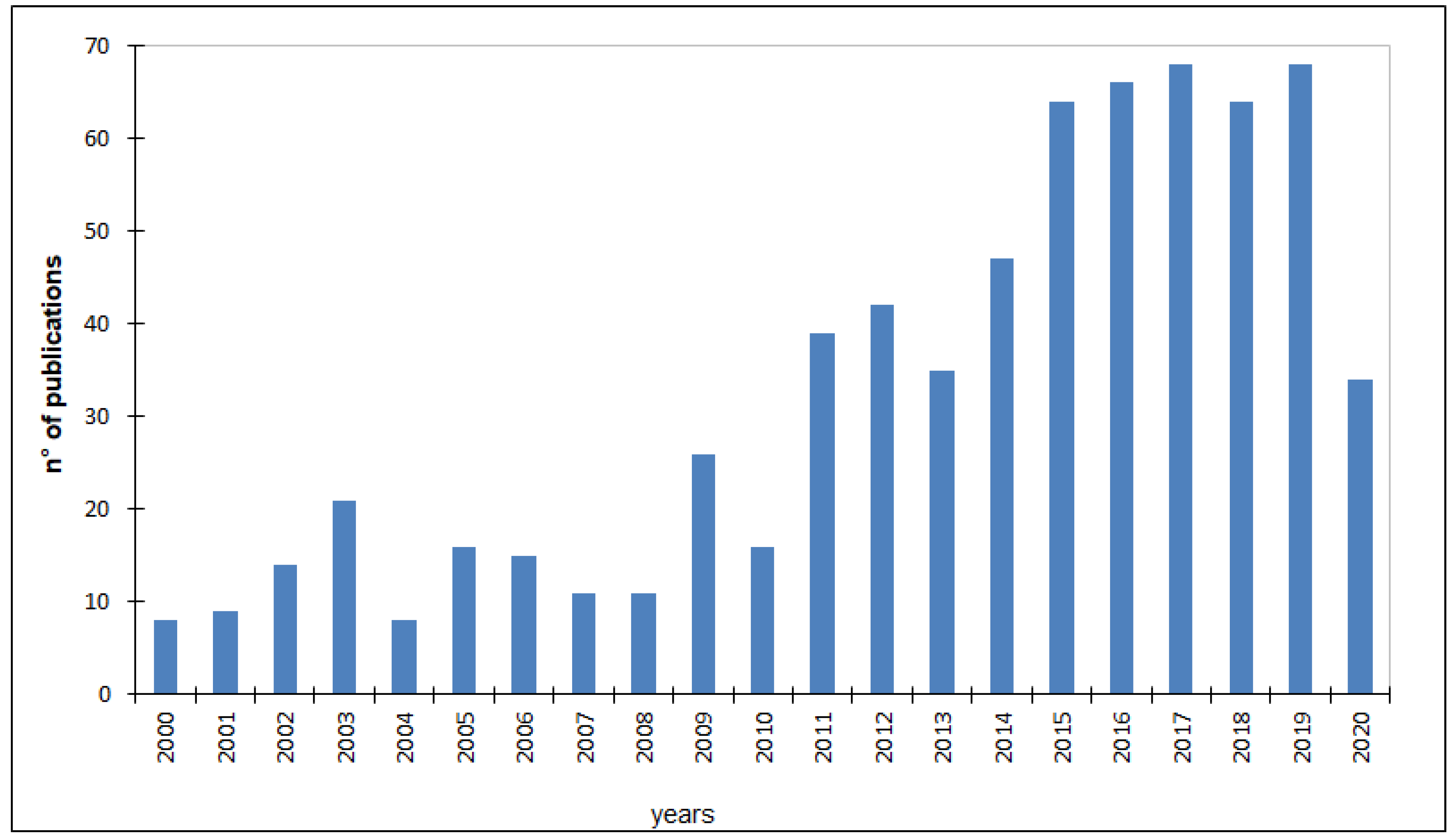
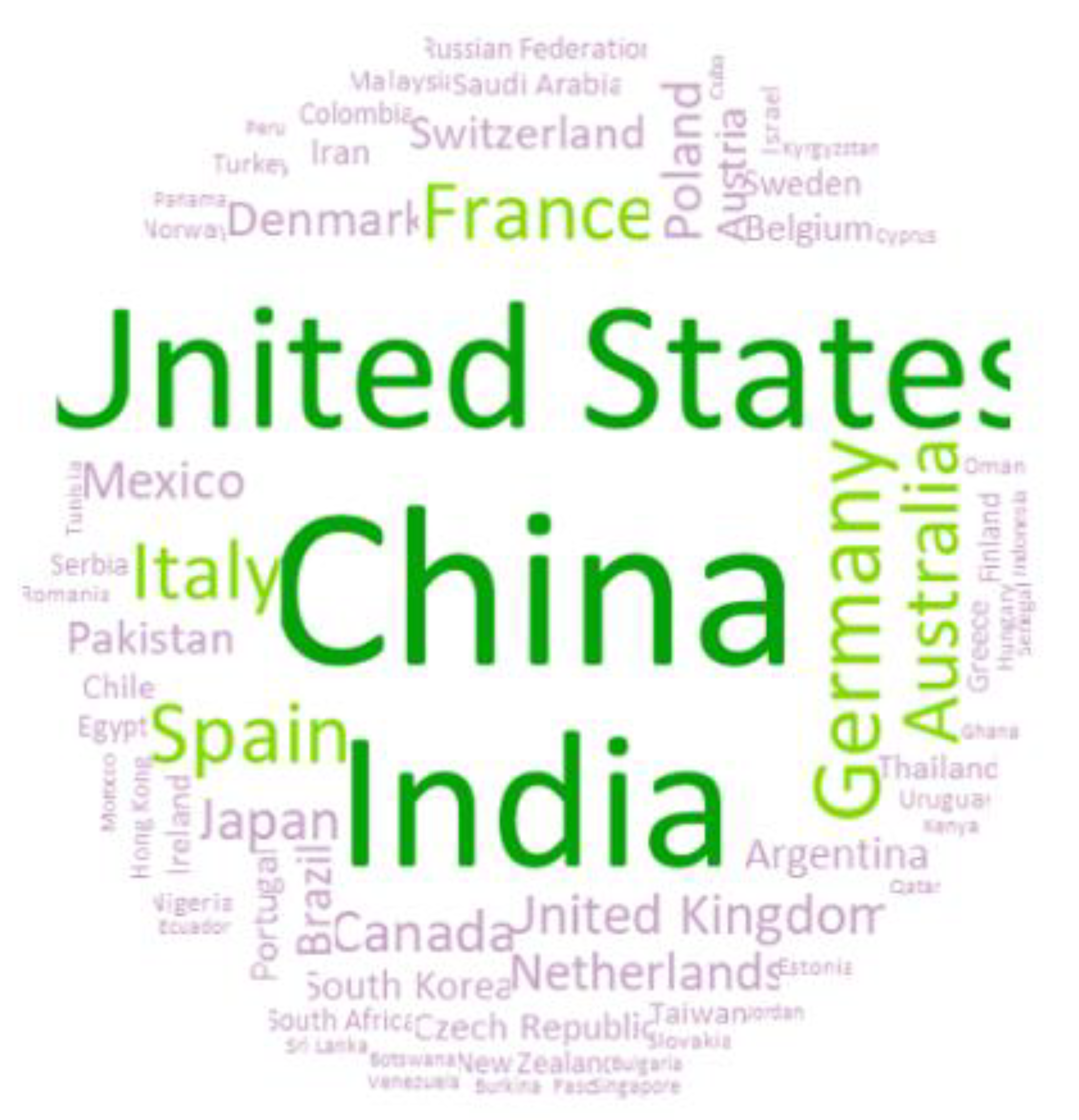

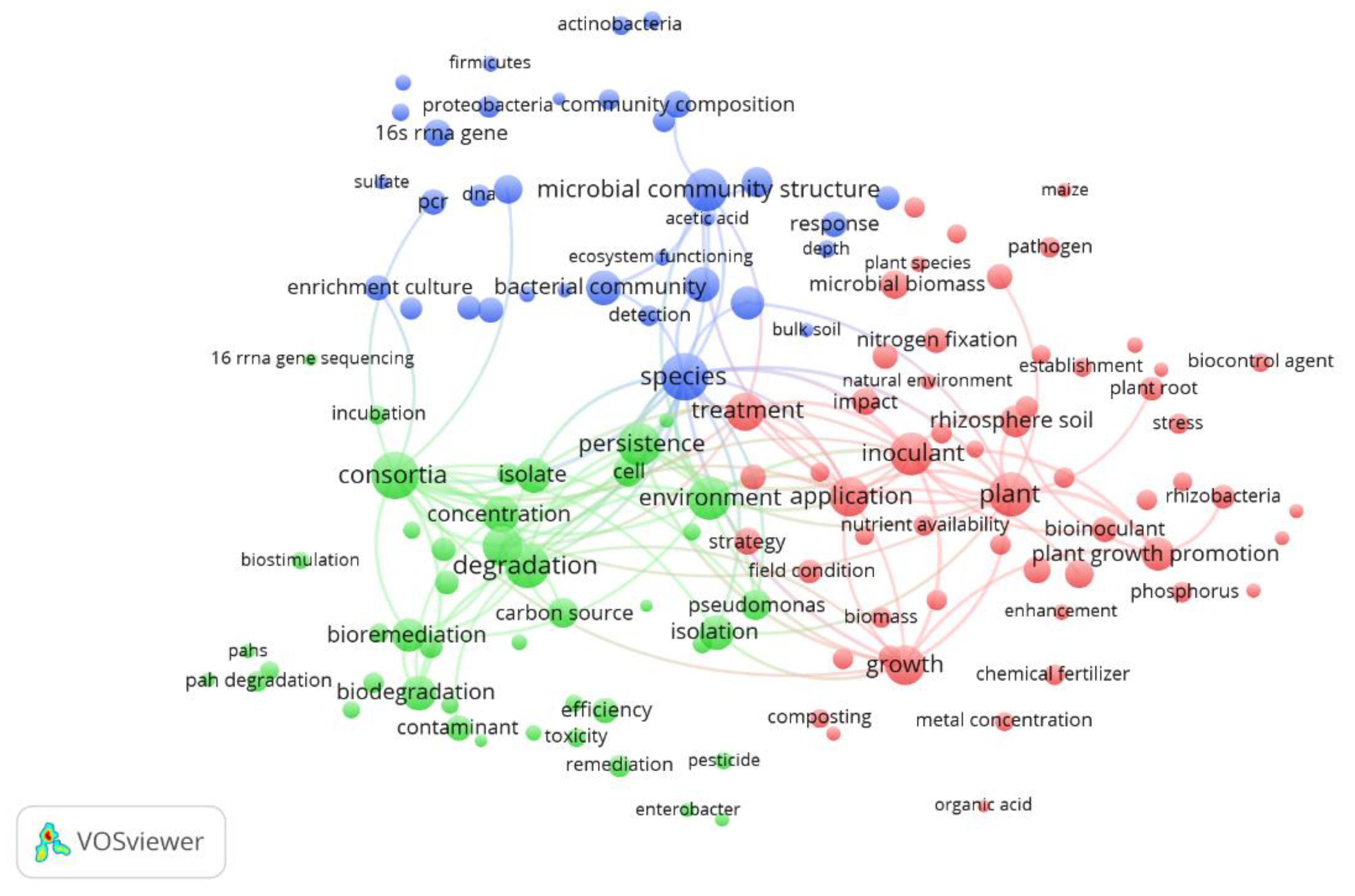
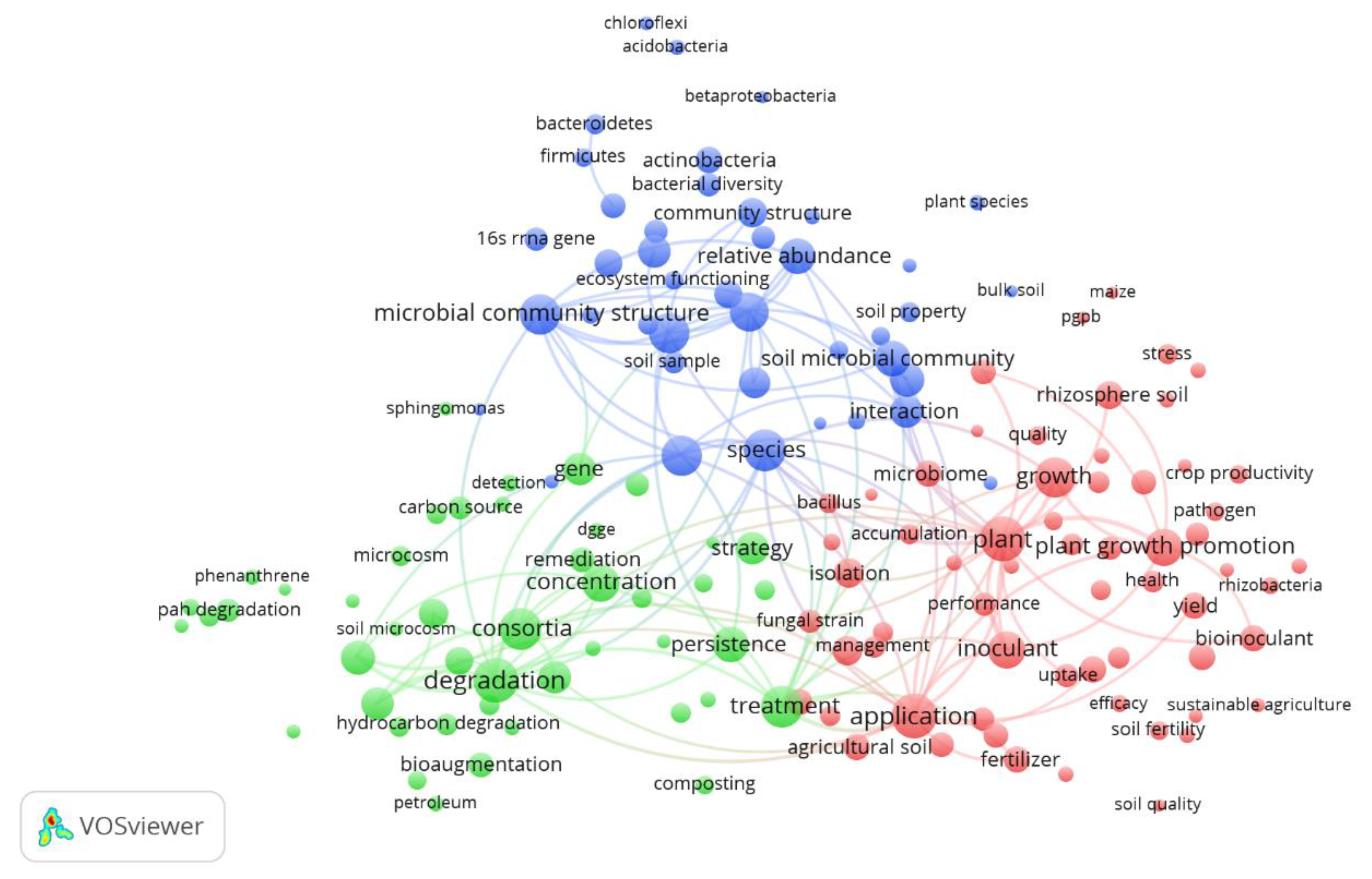
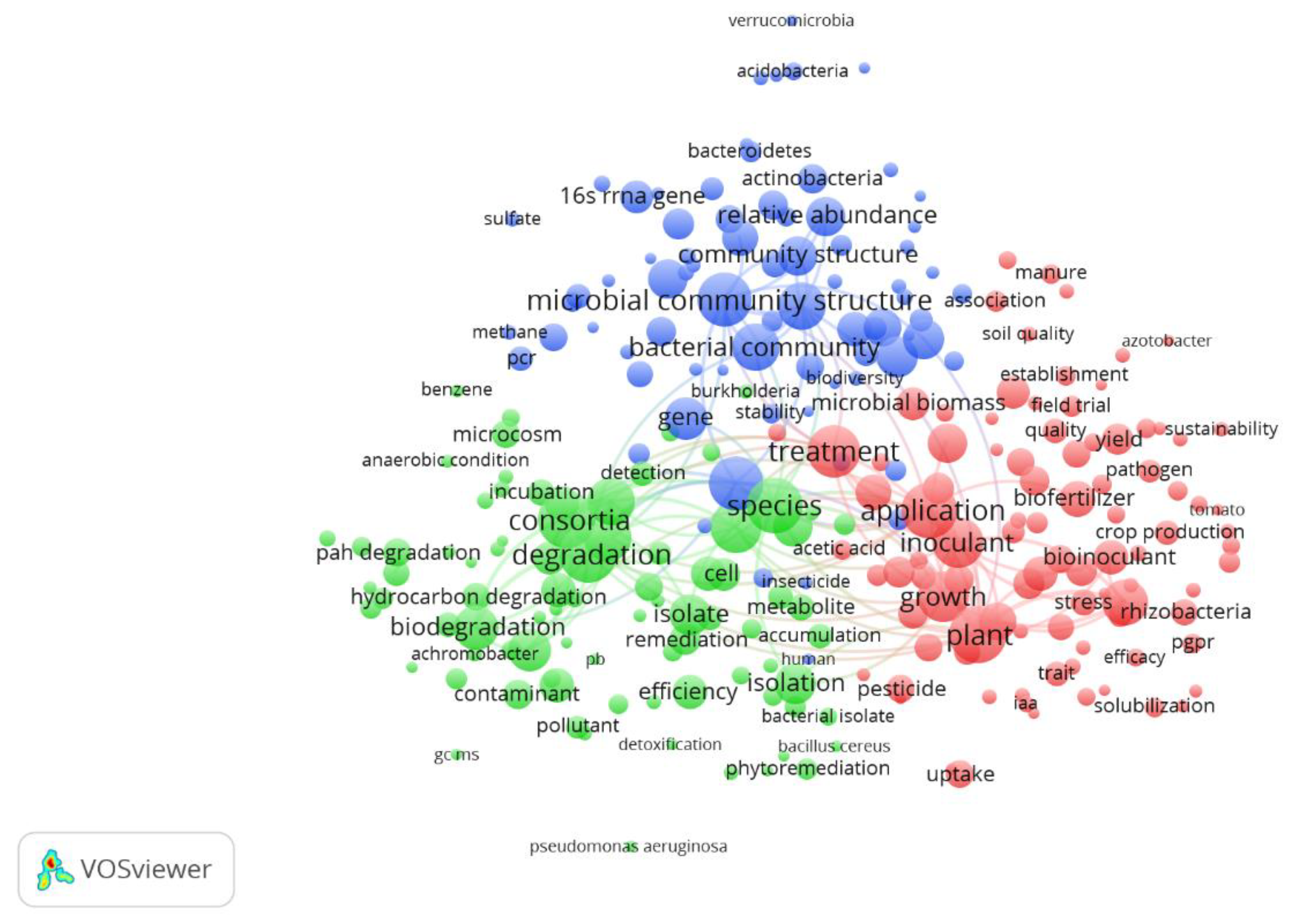
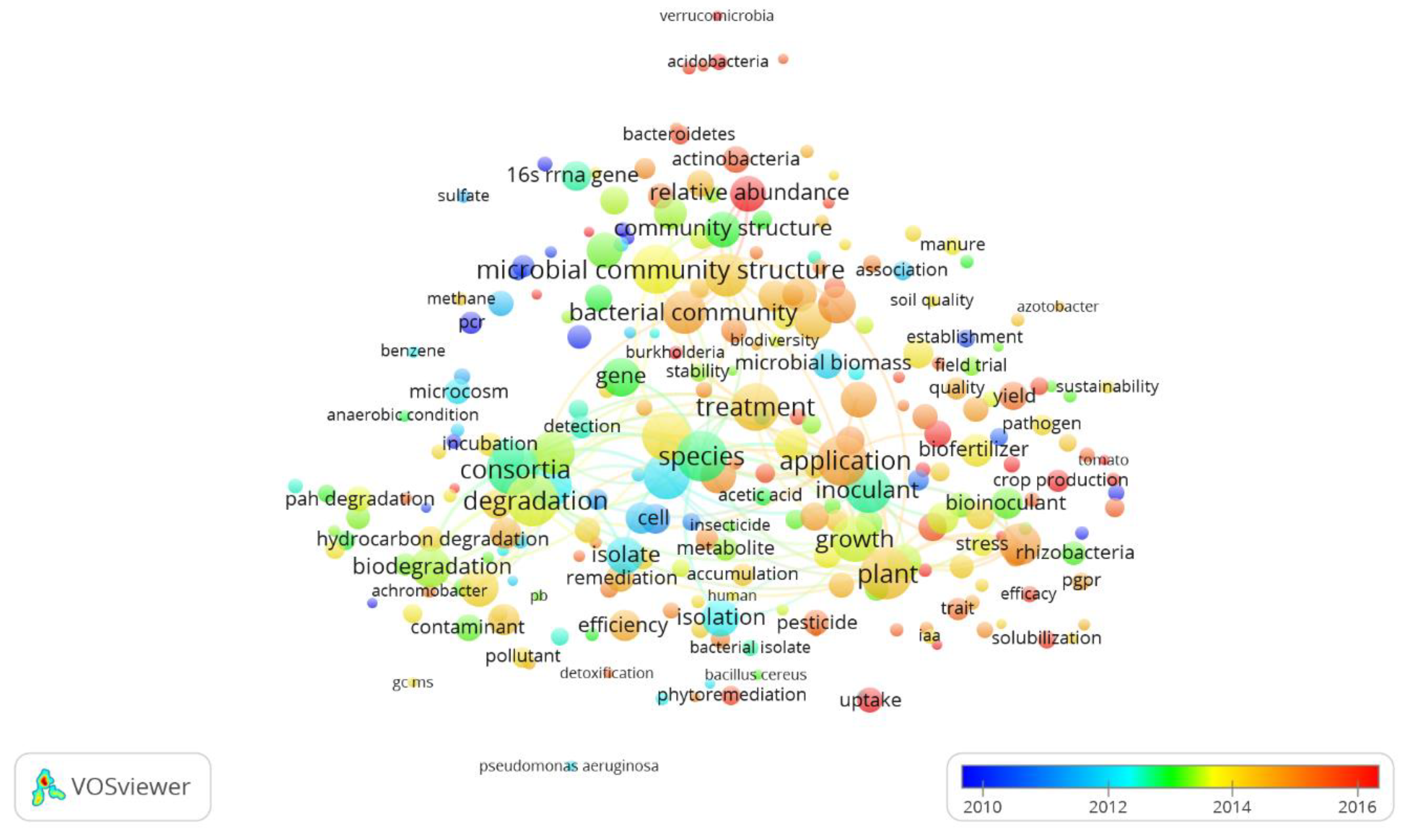

| Rank. | Journal | n° Publications | % Frequencies |
|---|---|---|---|
| 1 | Applied and Environmental Microbiology | 33 | 5.3 |
| 2 | Applied Microbiology and Biotechnology | 30 | 4.9 |
| 3 | Science of the Total Environment | 29 | 4.7 |
| 4 | Environmental Science and Pollution Research | 27 | 4.4 |
| 5 | Chemosphere | 25 | 4.1 |
| 6 | Journal of Hazardous Materials | 25 | 4.1 |
| 7 | FEMS Microbiology Ecology | 23 | 3.7 |
| 8 | International Biodeterioration and Biodegradation | 16 | 2.6 |
| 9 | Plant and Soil | 16 | 2.6 |
| 10 | Biodegradation | 15 | 2.4 |
| 11 | Journal of Environmental Management | 15 | 2.4 |
| 12 | Soil Biology and Biochemistry | 15 | 2.4 |
| 13 | Journal of Applied Microbiology | 13 | 2.1 |
| 14 | Microbiological Research | 13 | 2.1 |
| 15 | Environmental Science and Technology | 12 | 1.9 |
| 16 | Microbial Ecology | 12 | 1.9 |
| 17 | Plos One | 12 | 1.9 |
| 18 | Others | 286 | 0.3 |
| Subject Category | n° of Publications | % Frequencies |
|---|---|---|
| Environmental Science | 362 | 28.5 |
| Immunology and Microbiology | 267 | 21.0 |
| Agricultural and Biological Sciences | 266 | 20.9 |
| Biochemistry, Genetics and Molecular Biology | 190 | 14.9 |
| Chemistry | 54 | 4.2 |
| Chemical Engineering | 44 | 3.5 |
| Earth and Planetary Sciences | 23 | 1.8 |
| Materials Science | 18 | 1.4 |
| Multidisciplinary | 17 | 1.3 |
| Engineering | 15 | 1.2 |
| Others | 15 | 1.2 |
Publisher’s Note: MDPI stays neutral with regard to jurisdictional claims in published maps and institutional affiliations. |
© 2021 by the authors. Licensee MDPI, Basel, Switzerland. This article is an open access article distributed under the terms and conditions of the Creative Commons Attribution (CC BY) license (http://creativecommons.org/licenses/by/4.0/).
Share and Cite
Canfora, L.; Costa, C.; Pallottino, F.; Mocali, S. Trends in Soil Microbial Inoculants Research: A Science Mapping Approach to Unravel Strengths and Weaknesses of Their Application. Agriculture 2021, 11, 158. https://doi.org/10.3390/agriculture11020158
Canfora L, Costa C, Pallottino F, Mocali S. Trends in Soil Microbial Inoculants Research: A Science Mapping Approach to Unravel Strengths and Weaknesses of Their Application. Agriculture. 2021; 11(2):158. https://doi.org/10.3390/agriculture11020158
Chicago/Turabian StyleCanfora, Loredana, Corrado Costa, Federico Pallottino, and Stefano Mocali. 2021. "Trends in Soil Microbial Inoculants Research: A Science Mapping Approach to Unravel Strengths and Weaknesses of Their Application" Agriculture 11, no. 2: 158. https://doi.org/10.3390/agriculture11020158
APA StyleCanfora, L., Costa, C., Pallottino, F., & Mocali, S. (2021). Trends in Soil Microbial Inoculants Research: A Science Mapping Approach to Unravel Strengths and Weaknesses of Their Application. Agriculture, 11(2), 158. https://doi.org/10.3390/agriculture11020158









